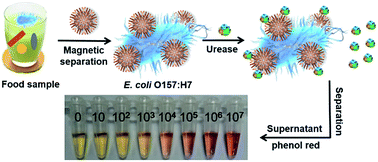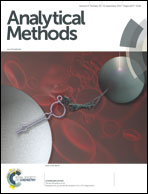Rapid and sensitive detection of E. coli O157:H7 based on antimicrobial peptide functionalized magnetic nanoparticles and urease-catalyzed signal amplification†
Abstract
The development of rapid and sensitive detection of foodborne pathogens could effectively prevent or reduce the outbreaks of foodborne diseases. Herein, a simple, rapid, and sensitive detection of E. coli O157:H7 was developed based on antimicrobial peptide functionalized magnetic nanoparticles (MNP–AMP) and urease-catalyzed signal amplification. In this study, MNP–AMP were fabricated to capture E. coli O157:H7 with a high efficiency via electrostatic and hydrophobic interactions. As the bacteria are captured by MNP–AMP, the binding sites for urease on the surface of MNP–AMP are blocked resulting in a large amount of urease in the supernatant after magnetic separation, which further induces the color change of the pH indicator by efficient catalytic hydrolysis of urea into ammonium. Due to the high capture affinity, efficient amplification strategy and simple manipulation, the proposed bioassay could detect E. coli O157:H7 as low as 12 cfu mL−1 within 30 min. Furthermore, this novel platform was successfully applied to detect E. coli O157:H7 in spiked apple juice and ground beef samples with a limit of detection of 84 and 233 cfu mL−1, respectively, indicating its potential application in real samples.



 Please wait while we load your content...
Please wait while we load your content...